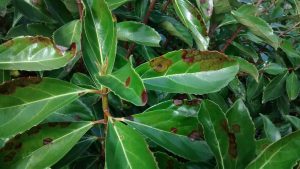 Downy mildew disease on Awabuki viburnum is prevalent right now. It can be a devastating disease causing severe defoliation. The disease is triggered by cooler, moist weather, especially foggy nights and mornings. Downy Mildew causes light green to reddish-brown leaf blotching, yellowing and defoliation. On the underside of the leaf, you may see white mildew growth.
Downy mildew disease on Awabuki viburnum is prevalent right now. It can be a devastating disease causing severe defoliation. The disease is triggered by cooler, moist weather, especially foggy nights and mornings. Downy Mildew causes light green to reddish-brown leaf blotching, yellowing and defoliation. On the underside of the leaf, you may see white mildew growth.
Management of cultural practices is important. Elimination of overhead and nighttime watering, excessive fertilization, overcrowded plantings and other stresses on the plants are helpful steps towards avoiding or reducing the occurrence of this pathogen. Make sure the sprinkler system does not directly hit the foliage as the water will disperse the spores causing the disease to spread throughout the hedge. Be sure to clean up fallen leaves – their removal can reduce disease activity significantly.
Effective management requires preventive fungicide applications. Once the disease gets started, you may not be able to adequately stop its progression and damage. You may need to repeat applications and remember to alternate products to minimize resistance.
Downy Mildew caused serious defoliation of one of the South Florida’s s favorite privacy hedges. Watch Doug Caldwell, UF/IFAS Extension Collier County and Debbie Gogan, Certified Pest Control Operator, discuss her successful methods for managing downy mildew in a lushly planted North Naples community here: https://www.youtube.com/watch?v=KTviHGd2Ims
Fungicide recommendations and more information on downy mildew is available here: http://edis.ifas.ufl.edu/pp329
 1
1
